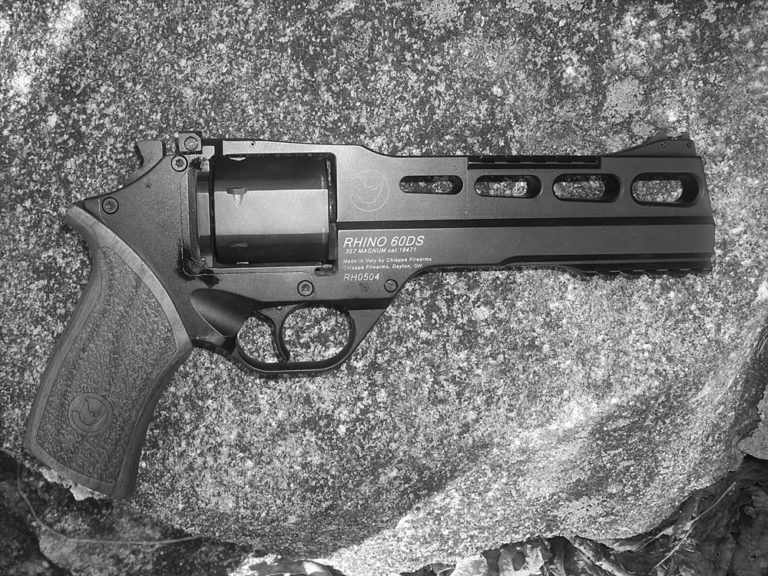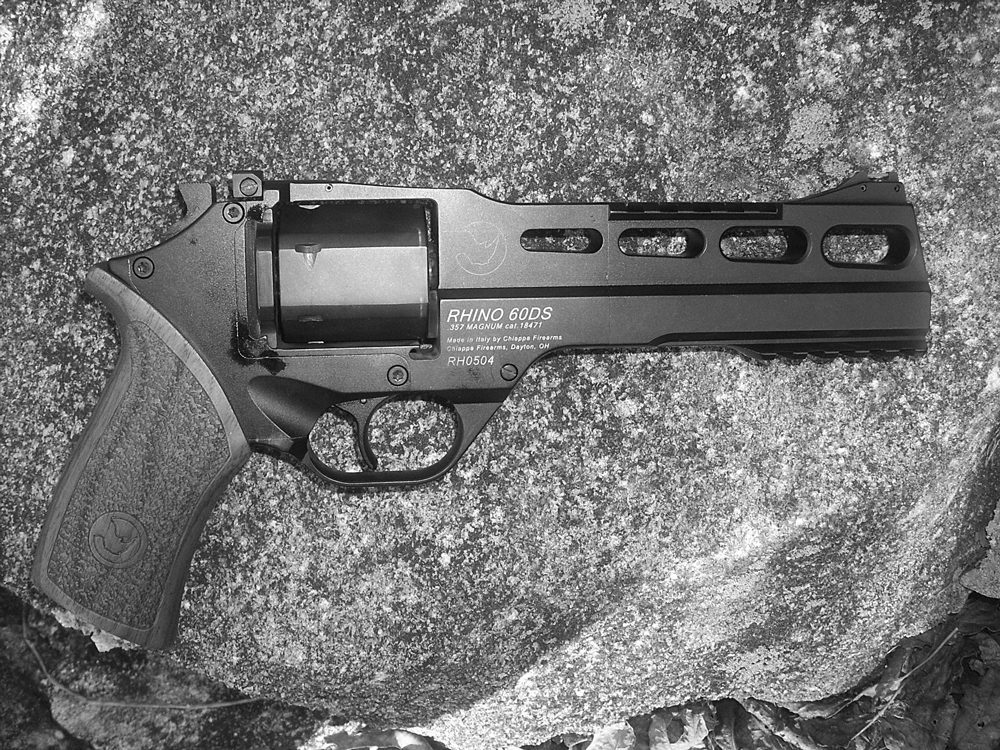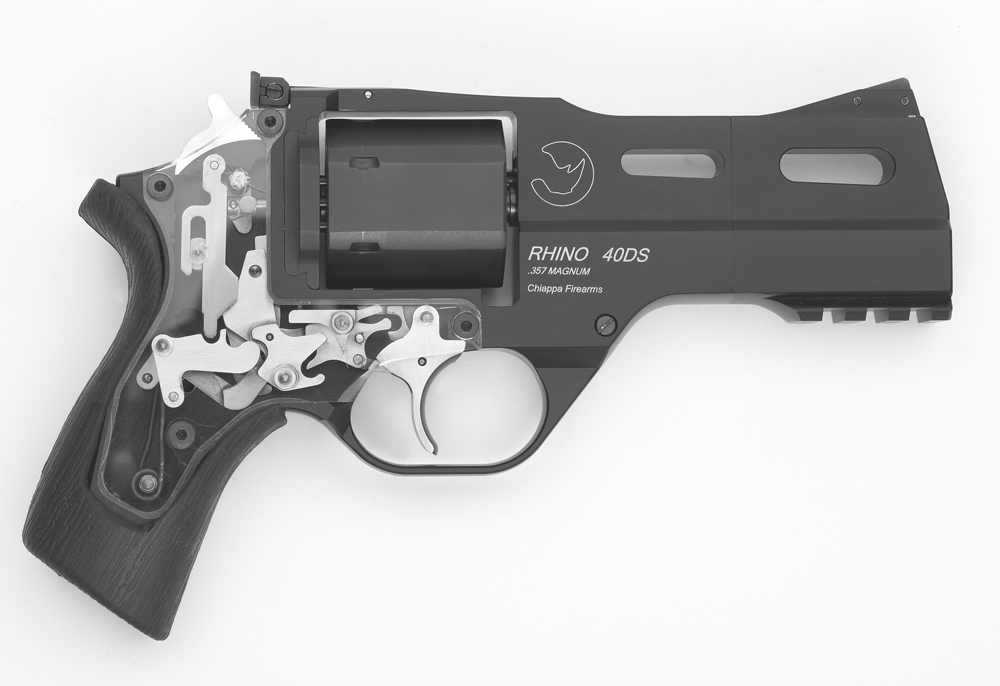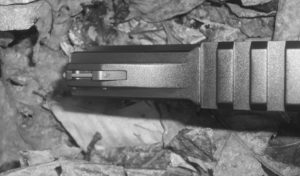

As one of the most innovative revolvers to be marketed to the American shooter, the Chiappa Rhino revolver fires from the bottom chamber to reduce reset time and recoil.
The Chiappa Rhino is the most innovative revolver to be marketed to the American shooter in more than a hundred years. It fires from the bottom chamber of the cylinder instead of the top for a more straight-line recoil that reduces muzzle jump and perceived recoil. Its innovative lockwork gives a 50 percent shorter trigger pull and a faster reset.
It is a major improvement in revolver design. This extends to the layout of the gun as well; the hand rides much higher on this gun than on conventional revolvers. Cowboy Action shooters will appreciate that, because one of the secrets of shooting the Colt Single Action Army was to hold it as high in the grip as possible; only then did it live up to its reputation as a natural pointer.
This also aids in putting the recoil more in line with the arm, instead of having the axis of the recoil above the hand as in a conventional revolver. Thus you don’t have the muzzle flipping up like that of a conventional revolver. The layout of the revolver results in its being 1 1/2 inches shorter in overall length than conventional revolvers with the same barrel length. Its imprint under clothes or in a pocket for the 2-inch barrel model is not as easily recognizable as a handgun as a conventional revolver is.
The Rhino is available in both fixed and adjustable sight versions and in barrel lengths of 2, 4, 5 and 6 inches, so there is something for everyone. Rifling is 6 grooves with a 1:18 3/4 inch twist. Working parts are steel and the frame is made of a high strength aluminum alloy called Ergal.

The mechanism is far different from that of conventional revolvers, as you would expect. Pulling the trigger moves an interlink lever by means of a connecting rod. This lever in turn moves both the hammer and the cylinder rotation pin, compressing a spiral spring through two levers. The interlink lever drives these two levers to push on the two spring ends which then propel the hammer and return the trigger and the rest of the mechanism to rest.
The Rhino’s double action is operated through a mobile hammer sear that cocks the hammer until it is released upon reaching the preset position, similar to the operation of a traditional revolver. The single action requires a different method due to the low position of the hammer. It was necessary to use an external hammer actuator that uses a lever to push the hammer down until it engages the counter-hammer, blocking it in the armed position.
When the trigger is pulled, the hammer is released by the interlink lever which pushes up the counter-hammer and allows the action to fire. If you wish to uncock the gun it is necessary to push down the counter-hammer, pulling the trigger to the end and gently releasing the hammer actuator as you would with a standard revolver.
The Rhino’s cylinder is released by a lever on the left side of the revolver. When pushed down, this lever engages the locking pin in the center of the rotation shaft. A spring makes the locking pin recoil and at the same time pushes back the pin in the breech shield, thus releasing the cylinder. Once the cylinder is released, it can be pushed to the left to allow the loading and unloading of the weapon.

You will encounter a slight resistance when pushing the cylinder to the left as you have to overcome the spring pressure of the second locking system of the cylinder. This consists of a spring loaded detent pin placed in the frame of the gun on the opposite side of the breech shield, which is wedged into a specific seat in the rotation arm of the cylinder. The arm of the cylinder is wedged in a special joint which allows ample space for opening of the cylinder for quick reloading.
Safety is a big part of this revolver’s design. The gun cannot fire without the cylinder being locked in place because if the small piston placed in the center of the rotation shaft of the cylinder is not perfectly seated into its notch in the breech shield, the cylinder opening lever will be in the low position, blocking rotation of the cylinder and stopping the whole mechanism.
The revolver cannot fire if the cylinder chamber in the six o’clock position is not aligned with the barrel. A pin placed on the trigger interferes with the plug blocking the cylinder and prevents the trigger from being fully pulled if the plug has not gone into its corresponding notch in the cylinder.
The internal hammer makes the Rhino extremely safe from accidental firing caused by falls and shocks. Nevertheless a special safety prevents the accidental release of the hammer when the revolver is cocked in single action. An accidental release of the hammer could happen only if the gun fell from a great height or as a result of abnormal wear of internal parts.

In this case the hammer cannot hit the firing pin as a solid plug on the left side of the frame would interfere with the interlink lever preventing the gun firing. This safety can only be disconnected by pulling the trigger fully through.
Advanced design means breaking with tradition and this makes the Rhino a real attention getter. When my 6-inch barrel sample gun arrived at Tucker Guns, it created quite a stir among the employees and customers. There were two standard reactions: “What in the Hell is that?” followed by “That’s weird!” Then the comments start to become complimentary: “Nicely machined!” “Points good!” “Has a good trigger pull,” etc. Everyone had to see it and play with it and all came away liking it.
I was the first gun writer to get one of the 6-inch barrel guns. Up to then everyone had gotten the 2-inch barrel snubnose. That’s fine for it’s purpose but I wanted to get all the accuracy and hunting potential out of the .357 Magnum. I am one of a long line of hunters who condemn the use of the .22LR for game shooting because of the high number of wounded animals that escape to die a lingering death after being imperfectly hit with the diminutive .22LR.Like many older hunters, I say the .32-20 is the best small and medium game cartridge, but it’s a bit hard to find today. Cost trumps humanity and sportsmanship for many folks so the .22 gets used and a lot of game dies a lingering death.
However, the .357 Magnum can be considered a larger-bored .32-20 with a little more killing power – not enough for deer but a far more sure and humane killer of small and medium game than the lowly .22LR. No, the .357 won’t spoil a lot of meat or be too powerful, and anyone with enough hunting ethics to want to kill their game cleanly without suffering will feel a lot better about using it than the .22LR.

The Rhino is produced by Chiappa Group in Azzano Mella in Northern Italy from all milled parts made on site. This is a very high-tech, modern facility dedicated to turning out a quality product. Its American subsidiary is Chiappa Firearms Ltd. This group is headed up by Ron Norton and their job is the development and marketing of Chiappa products in North America.
I test fired the Rhino extensively. I had 770 rounds of .38 Special and 500 rounds of .357 Magnum for a total of 1270 rounds. The breakdown was:
.38 Special
100 rounds Georgia Arms 148-grain wadcutter
100 rounds of CorBon 147-grain FMJ
150 rounds of Winchester 130-grain FMJ
100 rounds of BVAC 158-grain lead HP
100 rounds of Remington 158-grain lead RN
100 rounds of Federeal American Eagle 158-grain lead RN
120 rounds Winchester 130-grain JHP Bonded PDXI
150 rounds of NWCP 110-grain Manstopper
.357 Magnum
300 rounds Winchester 125-grain JHP
100 rounds Remington 125-grain JSP
100 rounds of North West Custom Projectile 110-grain Manstopper
I find the FMJ loads very useful. They offer increased penetration on bear or attackers in heavy clothing or behind cover. Sometimes more penetration is better, and not enough can get you killed. The military doesn’t use FMJ ammo for nothing. If the advantages of FMJ over expanding bullets in combat weren’t clear, no nation would have signed the treaties banning expanding bullets in combat. Creating a casualty behind cover is more important than stopping power in most military situations.
Anytime you fire a lot of .38 Special and .357 Magnum lead bullets you will have a lot of leading in the bore to clean out, and that is a feature that is no respecter of brand names. It is important to clean the residue at the front of the .357 cylinder out thoroughly if shooting .38 Specials as fouling can quickly build up on any revolver and interfere with chambering the longer .357 Magnum cartridges.
Firing the Rhino was a lot different from firing a conventional revolver. The grip rides much higher in the hand and what appears to be the hammer is a cocking lever that goes back down after the totally hidden internal hammer is cocked. A bright red cocking indicator pops up at the rear of the receiver to let you know it is cocked if the rearward single action position of the trigger wasn’t enough.
The cylinder is opened by that strange looking lever on the upper rear left side. Once moved back, this lever permits the flat-sided hexagonal (for concealability) cylinder to swing out for loading or unloading. The rear sight is framed by two green dots and the front sight has a red dot.
These are formed by plastic rods with exposed surfaces to catch the light in front of the sight blades, so you always have a bright group of dots even in poor light. Trigger pull was 4 pounds single action and 11 pounds double action as measured by the Lyman trigger pull gauge from Brownell’s gunsmithing supplies. This is quite acceptable, although I would prefer both to be lighter.

The Rhino’s barrel lies much lower than on other pistols and you can appreciate that and the short trigger travel on double action rapidfire. It is very fast and controllable. I just wish Bill Jordon was alive to see this because I think he would like it. Accuracy is all you need for hunting.
At 25 yards I was shooting and hitting 1 1/2- and 2-inch chips easily and centering a gratifying number of them with all ammo fired. I am not worried about missing any game fired at with this gun. I can think of a lot of rifles I would have less confidence in. The pistol points well for instinct shooting and is easy to hit with.
Aside from hunting, there are those who use the .357 Magnum revolver for police work. These users should try out the Rhino and see if its qualities make it the best choice for them. There is a lot of personal preference involved in choosing a revolver but many of those using the .357 Magnum revolver will be glad that they tried out the Rhino.
There are many factors one considers when selecting a revolver, some real and some imagined. The realities of the advantages the Rhino offers should more than offset its unconventional looks. Remember, the first revolvers looked pretty funny to everyone in 1836 but they sure did displace the single shot pistol.
The moral? Don’t be afraid to try something new. You might like it.
This article is an excerpt from Gun Digest 2012.

Next Step: Get your FREE Printable Target Pack
Enhance your shooting precision with our 62 MOA Targets, perfect for rifles and handguns. Crafted in collaboration with Storm Tactical for accuracy and versatility.
Subscribe to the Gun Digest email newsletter and get your downloadable target pack sent straight to your inbox. Stay updated with the latest firearms info in the industry.








It doesn’t matter what the price is, if nobody will carry it. It’s not available in California. It’s too new and too strange. The official company literature states that the MSRP as $800-$900.
4 pages and unless I just skimmed over it, what’s the price???